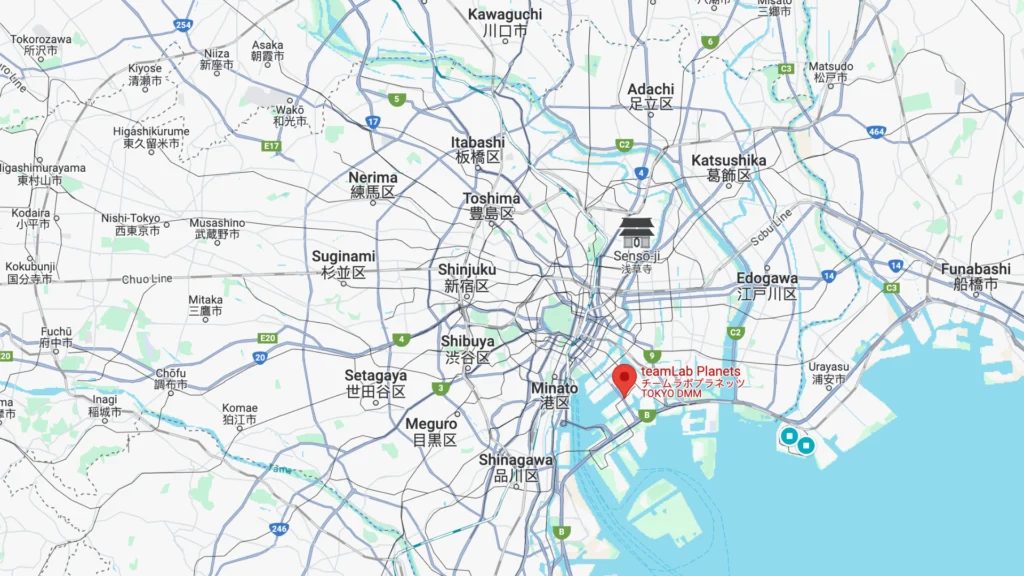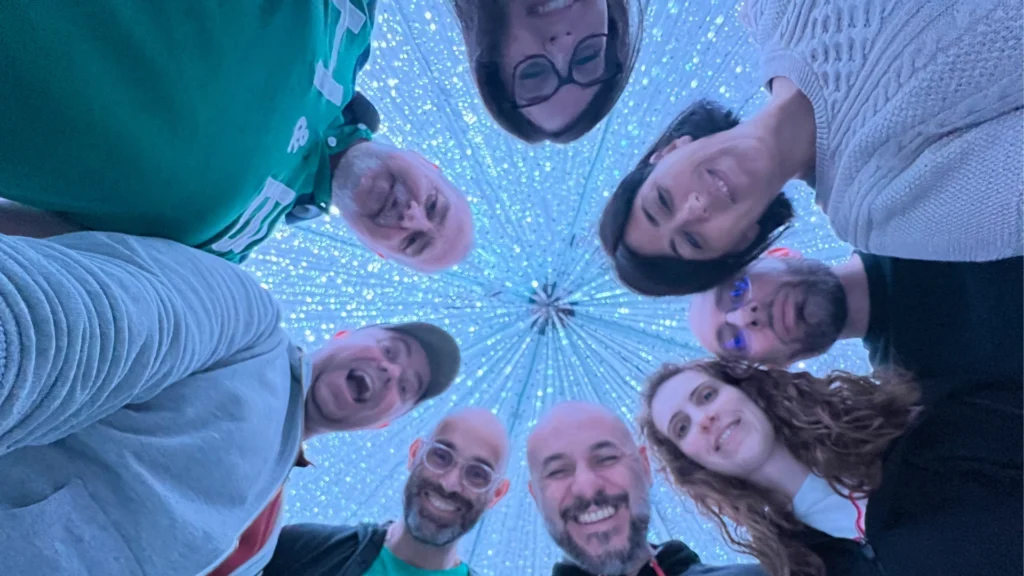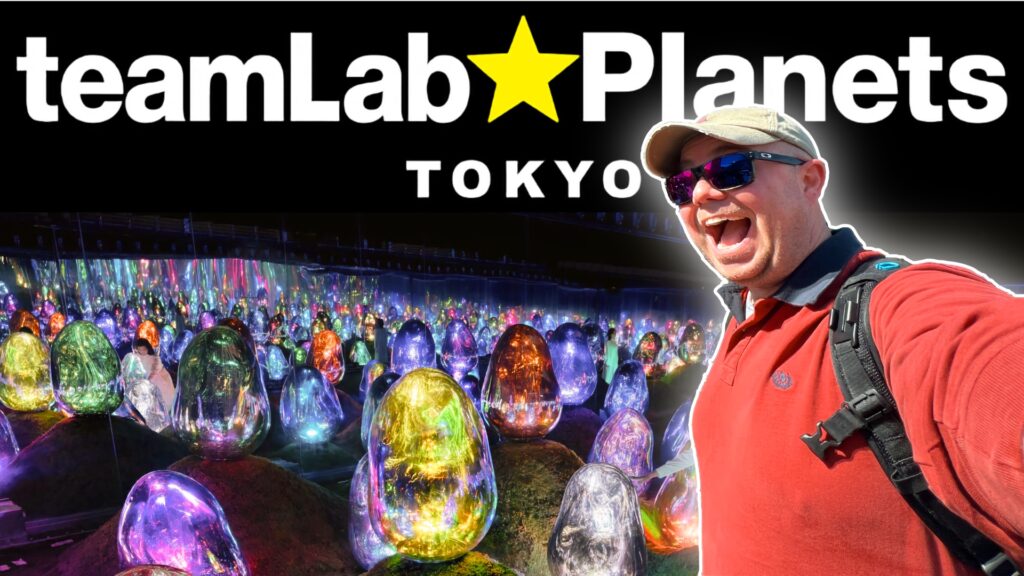Opened in the summer of 2018, Tokyo’s teamLab Planets is the pioneer of a new category of interactive museums where the visitor is not just a spectator but also the creator of their own personal experience.
In this article, you’ll find both my vlog from teamLab and a full description of the experience, including tips on how to visit it during your next trip to Japan.
If you’d love to visit Japan but don’t know who to go with, CLICK HERE to discover the group trips I organize every year.
Where is teamLab Planets located in Tokyo?
teamLab Planets Tokyo is located in the Odaiba area, south of central Tokyo.
The easiest way to reach it is by taking the Yurikamome Line (U Line) and getting off at Shin-Toyosu Station, which is right in front of the museum entrance.

What are the opening hours?
teamLab Planets is open every day from 9:00 AM to 10:00 PM, with the last admission one hour before closing.
Occasionally, closing times may vary due to private events, so I recommend checking the official website to stay up to date.
How much does teamLab Planets Tokyo cost?
Ticket prices vary depending on the day of your visit.
An adult ticket (18+ years old) costs 3,800 Yen from Monday to Friday and 4,200 Yen on weekends, holidays, and special days.
I highly recommend purchasing your ticket in advance from the official website, as it’s still extremely popular even after years of opening.
What are the different areas?
teamLab Planets Tokyo is divided into two distinct zones:
- the Water Area
- the Garden
As I describe the areas of teamLab Planets Tokyo, please note that everything is constantly evolving and changing — the information you’re about to read is accurate as of the publication date of this article.
The Water Area at teamLab Planets Tokyo
This is the most emotional and awe-inspiring area you’ll encounter.
First, you’ll need to store all your personal items — including shoes — in a free locker, roll up your pants, and follow the signs leading to the Water Area.
The path winds through hallways with various textured floors designed to stimulate your sense of touch, and many truly fascinating rooms.
I don’t want to spoil too much, but I’d love to describe three experiences that really moved me.
The Infinite Crystal Universe
This is perhaps the most famous and Instagrammed installation at teamLab Planets Tokyo.
Imagine a huge room where both the floor and walls are mirrors, with thousands of LED strands hanging from the ceiling, lighting up and dancing to the rhythm of the music.
Your sense of space is challenged, and even time seems to stop as you watch this emotional display.

Dance of Koi and People
This installation immerses you literally in nature.
You step into a shallow white pool of water about 30 cm deep — hence the rolled-up pants — where images of koi fish are projected as they swim freely.
The movement of the koi is influenced by the presence of people in the water, as well as by other koi. When the fish collide with people, they transform into flowers and scatter.
Throughout the year, the blooming flowers change with the seasons — in spring, they become cherry blossoms.
The koi’s trajectories are shaped by the people’s movements, tracing lines across the water’s surface.
The artwork is rendered in real time by a computer program — it is neither pre-recorded nor looped.
The interaction between the viewer and the installation causes continuous transformation within the artwork.
Floating in the Falling Universe of Flowers
This installation moved me the most.
The sense of peace and total immersion truly helped me relax and feel connected to nature.
A mirrored floor, a dome-shaped ceiling like a planetarium, images of petals and days gently falling, and soft music will make you almost lose your senses.
To fully enjoy it, I recommend lying on your back, focusing on a single point on the ceiling, and letting your mind drift away.
But be careful when getting up — it won’t be easy to keep your balance right away. Give your brain a moment to figure out where you’re going.
The Garden at teamLab Planets Tokyo
There are two different installations in this area.
Floating Flower Garden
In this room, which also has mirrored floors, you’ll see hundreds of orchids hanging from the ceiling, appearing to float in the air.
Their upward movement is influenced by your actions — if you approach, the flowers rise; if you move away, they lower.
For this reason, people can freely wander through the floral space. If you encounter other people inside the artwork, your space will connect with theirs, forming a single unified space.
Moss Garden
In the moss garden, ovoids are arranged that change appearance with sunrise and sunset.
At sunrise, the ovoids begin to reflect the surrounding world. When pushed down by a person or moved by the wind, the ovoid tilts backward and then stands up again, releasing a resonant tone. Nearby ovoids respond one after another, continuing to resonate with the same tone.
As the sun sets, the ovoids glow from within. When pushed by a person or the wind, an ovoid lights up and emits a tone as it rights itself. Surrounding ovoids respond one after another, emitting the same color and sound that continues to resonate.
Tips and Conclusion
These are my tips for making the most of your visit to teamLab Planets Tokyo:
- Book your tickets well in advance, but not too far ahead — tickets are available on the official website up to 70 days in advance
- Choose an entrance time around sunset — about an hour before — to fully enjoy the Moss Garden
- Arrive at least 30 minutes early so you have time to use the restroom (located before the entrance) and grab a drink from the vending machines
- Protect your smartphone with a waterproof case — most installations involve water, and you never know…
- Take your time to fully enjoy the experience, but follow staff directions — during busy times, time in each room may be limited
teamLab Planets Tokyo truly amazed me. I had seen other “similar” things around the world, but none had ever made me feel so emotional.
If you’re planning to visit Tokyo, don’t miss this experience.


